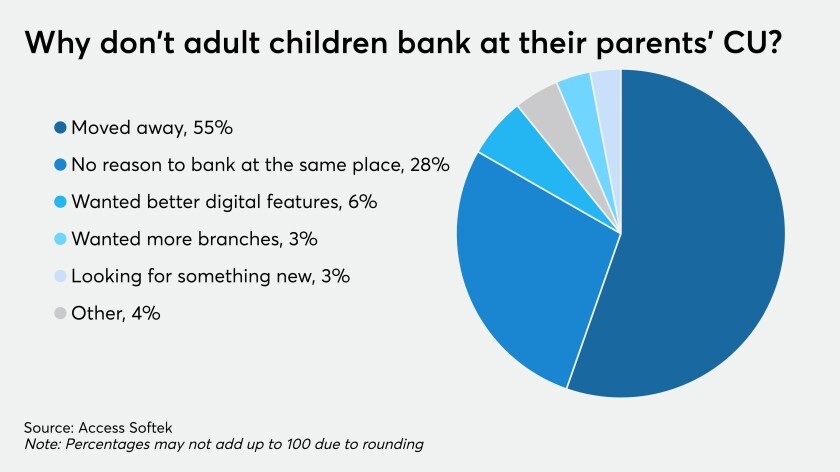The competition for youth accounts just became significantly more challenging for credit unions.
JPMorgan Chase earlier this month announced the launch of Chase First Banking, a new account for kids and teens managed through the megabank’s mobile app. Credit unions across the country have long offered a variety of accounts for young members in the hopes of establishing lasting relationships, but an offering from the nation’s largest bank represents a new level of competition for those accounts.
Credit unions “need to worry, because they have not kept up with what the big banks are doing and they’re aware of that,” said Chris Doner, CEO of Access Softek.

That’s backed up by a pair of recent surveys from Access Softek that defy some of the credit union industry’s conventional wisdom. A study from the company this summer showed 60% of young adults don’t bank at the same credit union as their parents, while just 9% of parents would recommend their credit union. That counters a long-held belief that if parents can get their children connected to their credit union early on it can serve as a springboard for a lifelong relationship.
Because the National Credit Union Administration doesn’t require regulated institutions to list what kinds of accounts they offer, it’s difficult to get a clear picture on exactly how many credit unions offer youth accounts. Many of those that do focus on savings — a natural fit for the industry, given its historic emphasis on thrift and establishing good savings habits — but there’s a growing sense that if credit unions want to compete, these accounts may also need a transactional component along with financial education.
Chase’s account is divided into three categories — Spend, Save and Earn — and also includes a debit card that can be used with parental permission and allows adults to set spending limits.
A Chase representative said by email that while the company doesn’t share projections for account penetration, management believes there is demand for the product.
“Over 75% of parents have told us that they want a product that can help them teach their kids about money," the representative said. "It is important for us to offer options that help families get on the road to financial health starting at a young age — kids that learn to save early have a [six times greater] chance of going to college.”
If credit unions want to make inroads with youth accounts, they “can’t just say [to young members], ‘Give us $5 and we’ll give you a sticker,’” quipped Marne Franklin, CEO of Uncommn Marketing Partners, which works with credit unions to offer a variety of branded accounts for kids and teens. Institutions need to give young members — and their parents — a reason to stay, and an account they can actually use could be part of that equation.
“Kids are savvy and they’re a portion of commerce that they didn’t use to be,” said Franklin. “Kids in junior high and high school have buying power and are spending money. The financial education aspect of it that used to be in school, a lot of that is gone completely; So the youth programs have to have a combination of, ‘You can save your money here,’ but also have the education piece of, ‘We don’t expect you to save every dollar you get.’”
Many credit unions’ accounts for kids “tend to be more of a savings account” with some sort of financial education component, said Trysh Olson, manager of youth and education programs at Wings Financial in Minnesota and chair of the National Youth Involvement Board, a group that helps credit unions reach young consumers.
Many credit unions may have shied away from the transactional side of these accounts, she suggested, because they aren’t prioritizing fee income. Because of that, they may not feel the need to get debit cards in younger members' hands that can help bring in interchange revenue.
Olson noted that while Chase developed the new account alongside Greenlight, a fintech focused on helping develop financially savvy kids, it is hardly the first bank or vendor to go after this demographic.
So how much should credit unions worry?
“It’s one more product,” said Franklin. “I don’t know that people are necessarily going to pull all of their money out of a credit union and run over to Chase because they offer this, but it is one [more] differentiator.”
As smaller institutions, Doner said, credit unions are often nimble enough to quickly launch new products and adjust them as needed.
“For years now people have been talking about the aging of the credit union membership, and time is not on their side with current demographics,” he said. “There’s a response they can take to that: they need to take up new technology being adopted by the younger generation, and if they do that then they can compete.”
Doner pushed back on the notion that credit unions haven’t adopted technology because they lack the financial resources.
“We used to hear that with mobile banking, that only the big banks can afford to do it, but there were inexpensive solutions out there,” he said. “If credit unions had to develop everything internally form scratch it would be too expensive … but by having an attitude that they want to be on the leading edge of technology and listening to technology vendors out there and the solutions they offer, they have enough resources to be competitive. It’s more about the position they choose to maintain in the technology curve.”
"much" - Google News
October 21, 2020 at 04:00PM
https://ift.tt/37sRYtJ
How much should Chase's new kids' account concern credit unions? - American Banker
"much" - Google News
https://ift.tt/37eLLij
Shoes Man Tutorial
Pos News Update
Meme Update
Korean Entertainment News
Japan News Update
Bagikan Berita Ini















0 Response to "How much should Chase's new kids' account concern credit unions? - American Banker"
Post a Comment